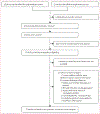Post-discharge morbidity and mortality in children admitted with severe anaemia and other health conditions in malaria-endemic settings in Africa: a systematic review and meta-analysis
- PMID: 35605629
- PMCID: PMC10196725
- DOI: 10.1016/S2352-4642(22)00074-8
Post-discharge morbidity and mortality in children admitted with severe anaemia and other health conditions in malaria-endemic settings in Africa: a systematic review and meta-analysis
Abstract
Background: Severe anaemia is associated with high in-hospital mortality among young children. In malaria-endemic areas, surviving children also remain at increased risk of mortality for several months after hospital discharge. We aimed to compare the risks of morbidity and mortality among children discharged from hospital after recovery from severe anaemia versus other health conditions in malaria-endemic settings in Africa.
Methods: Following PRISMA guidelines, we searched PubMed, Scopus, Web of Science, and Cochrane Central from inception to Nov 30, 2021, without language restrictions, for prospective or retrospective cohort studies and randomised controlled trials that followed up children younger than 15 years for defined periods after hospital discharge in malaria-endemic countries in Africa. We excluded the intervention groups in trials and studies or subgroups involving children with sickle cell anaemia, malignancies, or surgery or trauma, or those reporting follow-up data that were combined with the in-hospital period. Two independent reviewers extracted the data and assessed the quality and risk of bias using the Newcastle Ottawa Scale or the Cochrane Collaboration's tool. The coprimary outcomes were all-cause death and all-cause readmissions 6 months after discharge. This study is registered with PROSPERO, CRD42017079282.
Findings: Of 2930 articles identified in our search, 27 studies were included. For children who were recently discharged following hospital admission with severe anaemia, all-cause mortality by 6 months was higher than during the in-hospital period (n=5 studies; Mantel-Haenszel odds ratio 1·72, 95% CI 1·22-2·44; p=0·0020; I2=51·5%) and more than two times higher than children previously admitted without severe anaemia (n=4 studies; relative risk [RR] 2·69, 95% CI 1·59-4·53; p<0·0001; I2=69·2%). Readmissions within 6 months of discharge were also more common in children admitted with severe anaemia than in children admitted with other conditions (n=1 study; RR 3·05, 1·12-8·35; p<0·0001). Children admitted with severe acute malnutrition (regardless of severe anaemia) also had a higher 6-month mortality after discharge than those admitted for other reasons (n=2 studies; RR=3·12, 2·02-4·68; p<0·0001; I2=54·7%). Other predictors of mortality after discharge included discharge against medical advice, HIV, bacteraemia, and hypoxia.
Interpretation: In malaria-endemic settings in Africa, children admitted to hospital with severe anaemia and severe acute malnutrition are at increased risk of mortality in the first 6 months after discharge compared with children admitted with other health conditions. Improved strategies are needed for the management of these high-risk groups during the period after discharge.
Funding: Research Council of Norway and US Centers for Disease Control and Prevention.
Copyright © 2022 Elsevier Ltd. All rights reserved.
Conflict of interest statement
Declaration of interests
We declare no competing interests.
Figures




Comment in
-
Severe anaemia and paediatric mortality after hospital discharge in Africa.Lancet Child Adolesc Health. 2022 Jul;6(7):447-449. doi: 10.1016/S2352-4642(22)00103-1. Epub 2022 May 21. Lancet Child Adolesc Health. 2022. PMID: 35605630 Free PMC article. No abstract available.
References
-
- UN Inter-agency Group for Child Mortality Estimation. Levels and trends in child mortality: report 2018, estimates developed by the UN Inter-agency Group for Child Mortality Estimation. 2018. https://www.unicef.org/publications/index_103264.html (accessed April 29, 2022).
-
- WHO. Severe falciparum malaria. 2000. https://www.who.int/malaria/publications/atoz/who-severe-malaria-tmih-su... (accessed April 29, 2022).
-
- English M, Ahmed M, Ngando C, Berkley J, Ross A. Blood transfusion for severe anaemia in children in a Kenyan hospital. Lancet 2002; 359: 494–95. - PubMed
-
- Koram KA, Owusu-Agyei S, Utz G, et al. Severe anemia in young children after high and low malaria transmission seasons in the Kassena-Nankana district of northern Ghana. Am J Trop Med Hyg 2000; 62: 670–74. - PubMed
Publication types
MeSH terms
Grants and funding
LinkOut - more resources
Full Text Sources
Medical

